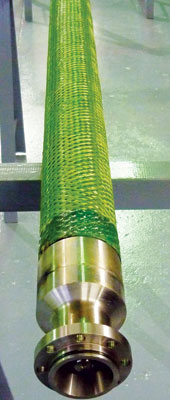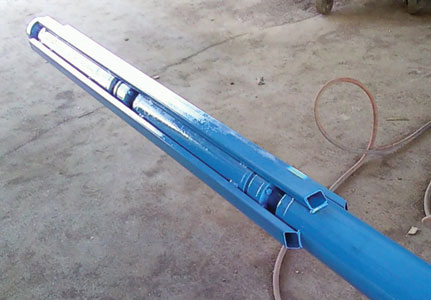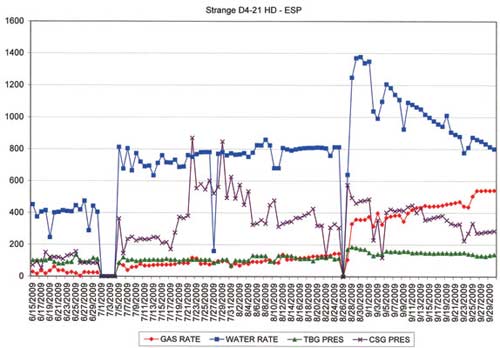简介:由于全球油气价格上扬,煤层气钻采经历了2007和2008的阶段性的繁荣,这一短暂的发展,也让该行业在众多方面获益匪浅。环球油服公司针对煤层气开采过程中,排水和腐蚀问题,开发出一种新型电潜泵,该泵有过滤网和防砂罩,能够有效的避免泵堵塞和腐蚀。同时经过改进,能够有效地防止抽水过程中气锁问题的出现,地面产水量也会随之大量减少。
Coalbed methane (CBM) drilling and production experienced a major boom in 2007 and 2008 as global hydrocarbon prices peaked. The boom benefited the industry in more than the obvious ways.
High commodity prices sparked exploration and development across North America that identified several new basins. The subsequent spike in CBM activity produced valuable learnings and technology developments that reduced drilling and completion costs.

Figure 1. The new Fluid Filtration Tool effectively keeps sand and coal fines out of the pump, preventing plugging or erosion of components. (Images courtesy Global Artificial lift)
The “Green” movement added impetus as the public demanded access to clean-burning fuel for heating and for electricity generation. Demand helped sustain gas prices above the plateau where they had languished for decades. While CBM has always been a marginal play, with activity limited to the shallow, easy-to-drill-and-produce fields, the brighter future for the natural gas market produced some singularly spectacular results, which many say would never have been realized under previous economic conditions.
Now that the market has returned from its euphoric state of 2007-2008, in a business sustained by increasing demand, technology will still find ways to help producers succeed economically in coal seam development. By way of example, Global Oilfield Services is attacking two completely different CBM plays in North America with excellent and sustainable results.
Economics is the ultimate driver
In the Powder River Basin, mainly in Wyoming, the large volume of water that must be pumped off to reduce formation pressure so the gas can come out of the coal represents the principle challenge facing producers. The wells must be dewatered continually, and the water must be disposed of in an environmentally acceptable way, usually through evaporation ponds or reinjection into a saltwater aquifer. In some cases, the produced water can be treated and certified for land irrigation purposes.

Figure 2 Strategically placed conduits channel water down to the pump intake, while gas separates and continues up the annulus. A gas handler right before the pump intake separates any remaining entrained gas to maintain pump prime.
The most practical and economical way to dewater the coal seam wells is through the use of electrical submersible pumps (ESP). Pumps are light-duty 400-series pumps with two bushings per pump driven by an oil-filled water-well motor. Oil well motors with protectors are preferred because they can take more heat, but they are more costly, so many producers stick with water well motors despite the risk.
Typical problems include sand or coal fines production, gas lock, and corrosion. As could be expected, pump problems cause motor problems, not vice versa. Sanding problems range from 0% to 100%, depending on the formation and the quality of the completion. The sand is fine-grained, like talc, and can erode or plug the pump. Global’s solution is to equip the pumps with a laminated screen or a sand shroud. In severe cases, the producer may complete the well using a gravel pack completion to forestall sanding. Recently a Fluid Filtration Tool (FFT) has been developed that has been installed in several wells to date and is demonstrating early success.
Gas locking is also a significant problem affecting up to 80% of installations. Global deals with this problem by adding advanced centrifugal gas separators upstream of the pump to separate the gas and move it to the casing/tubing annulus, where it is produced to surface. Unlike a typical oil well, where the desired product is produced up through the tubing, a coal seam well produces the undesirable water up through the tubing and lets the gas rise up through the annulus. A problem with gas locking is that it seldom manifests itself at the outset, only appearing after formation pressure is reduced below the critical point where the gas starts desorbing from the coal seam. Most pumps are equipped with “motor-saver” switches that shut down the motor before gas locking causes them to overheat. Many are automatic and can re-start the pump when the hydraulic head pressure is sensed.
The final problem affecting ESPs is corrosion. This varies from well to well but is usually associated with either CO2 or H2S presence. Solutions include using coated pump components or making impellers and diffusers out of corrosion-resistant alloys, although the latter raises pump costs considerably. The practice of feeding corrosion inhibitors down a small diameter capillary tube, as used in many conventional oil or gas wells, is considered uneconomic in the CBM world. In severe corrosion areas it may be economical to pay more for the pump to add longevity rather than pay for frequent replacements with concurrent downtime and lost production.
Good news from the East
Two examples from the central US illustrate the benefits of innovative technology tempered by the economic factor. In Oklahoma, an operator chose Global to equip 10 to 20 of its horizontal coalbed wells with ESPs. The wells averaged between 2,200 and 2,800 ft (671 and 854 m) in depth. They had lateral pay sections ranging from 700 to 1,400 ft in length (213 to 427 m). The coal was hard, and the well bores had high mechanical integrity. After working out both cases, the producer concluded that it was preferable to use low-cost water-well pumps even if the replacement cycle was every three months. Global experts recommended that pump monitors be installed to prevent collateral damage. In this way, as soon as a pump gave signs of impending problems such as an increase in motor winding temperature or excessive vibration, it could be shut down and pulled before serious damage occurred. Rebuild charges for undamaged pumps average about US $600 each compared with replacement costs for pumps damaged beyond repair, which can run several thousand dollars each.
Another operator in the Illinois Basin has benefited from unique innovative technology. Global has have applied for a patent for its Gas/Fluid Inhibitor System. After equipping nine of the company’s wells with the system, operators have seen gas production ramp up from 50,000 cf/d to 450,000 cf/d while fluid rates were boosted from 400 b/d to 1,200 b/d.

Figure 3. A dramatic improvement in well performance was realized initially when the Gas/Fluid Inhibitor was installed on July 4, 2009, and again when it was re-sized Aug. 26, 2009.
The concept of the new system is to take advantage of the natural separation of gas from water to keep the pump from losing its prime due to gas locking, and it works in both horizontal and vertical installations. Water in the well is channeled down to the pump intake via four square tubing conduits placed at 90° intervals around the pump. At the same time, a large majority of gas that has separated out of the water is channeled up the casing-tubing annulus to the surface where it is taken off. The water that enters the upper ends of the tubing conduits contains minimal amounts of gas and is further de-gassed by the centrifugal gas separator just upstream from the pump intake. This ensures that the pump stages rarely experience gas lock.
To date, gas production has been increased by as much as 400% in the wells where the new equipment has been installed, while water production to surface has been reduced as much as 57%.
杨宝剑 是全球石油网的高级技术编辑,在石油技术资讯行业有八年的学识和经验。他源源不断地提供石油行业全球最新的技术创新、研发成果、现场应用情况等信息。如果你对该项新技术有任何的疑问,或者对“新技术新产品”未来的内容有任何问题或建议,请联系杨宝剑编辑 +86 10-58236512 Email:allenyo#zhenweiexpo.com (将#变成@)欢迎与网站互动!


